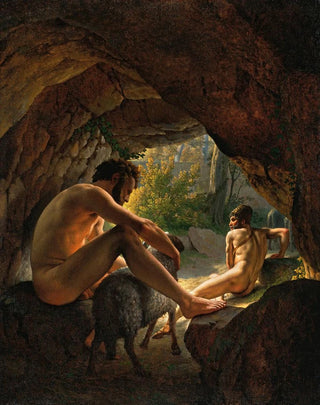Art print | Ulysses fleeing the cave of Polyphemus - Christoffer Wilhelm Eckersberg


View from behind

Frame (optional)
In the fascinating world of art, some works stand out for their ability to capture mythological narratives with unparalleled emotional depth. The art print Ulysses fleeing the cave of Polyphemus - Christoffer Wilhelm Eckersberg is part of this tradition, evoking not only Ulysses' bravery but also the struggle between man and destiny. This iconic scene, inspired by Homer's Odyssey, transports the viewer to a pivotal moment where intelligence and courage triumph over brute force. Through this piece, Eckersberg invites us to contemplate the human condition while immersing us in a refined and powerful aesthetic.
Style and uniqueness of the work
Eckersberg's work is characterized by remarkable technical mastery, where light and shadow intertwine to create an atmosphere that is both dramatic and poetic. The composition is carefully balanced, highlighting Ulysses' escape from the cave, while Polyphemus, the cyclops, stands in a threatening posture. The meticulous details of the faces and bodies, as well as the subtle use of colors, testify to a deep commitment to realism and faithful representation of emotions. The dynamic between the characters, accentuated by the palpable tension in the air, makes this work a true theatrical scene, where every gaze and gesture tells a story. Eckersberg thus manages to transcend the simple mythological narrative to offer a reflection on struggle, cunning, and survival.
The artist and his influence
Christoffer Wilhelm Eckersberg, often considered the father of Danish realism, marked his era with an innovative approach to painting. Trained at the Royal Danish Academy of Fine Arts in Copenhagen, he was able to combine classical influences with a modern outlook, which allowed him to stand out in the 19th-century artistic landscape. His fascination with mythology and human nature is reflected in many works, but it is in "Ulysses fleeing the cave of Polyphemus" that he manages to capture the very essence of the epic.

Matte finish

View from behind

Frame (optional)
In the fascinating world of art, some works stand out for their ability to capture mythological narratives with unparalleled emotional depth. The art print Ulysses fleeing the cave of Polyphemus - Christoffer Wilhelm Eckersberg is part of this tradition, evoking not only Ulysses' bravery but also the struggle between man and destiny. This iconic scene, inspired by Homer's Odyssey, transports the viewer to a pivotal moment where intelligence and courage triumph over brute force. Through this piece, Eckersberg invites us to contemplate the human condition while immersing us in a refined and powerful aesthetic.
Style and uniqueness of the work
Eckersberg's work is characterized by remarkable technical mastery, where light and shadow intertwine to create an atmosphere that is both dramatic and poetic. The composition is carefully balanced, highlighting Ulysses' escape from the cave, while Polyphemus, the cyclops, stands in a threatening posture. The meticulous details of the faces and bodies, as well as the subtle use of colors, testify to a deep commitment to realism and faithful representation of emotions. The dynamic between the characters, accentuated by the palpable tension in the air, makes this work a true theatrical scene, where every gaze and gesture tells a story. Eckersberg thus manages to transcend the simple mythological narrative to offer a reflection on struggle, cunning, and survival.
The artist and his influence
Christoffer Wilhelm Eckersberg, often considered the father of Danish realism, marked his era with an innovative approach to painting. Trained at the Royal Danish Academy of Fine Arts in Copenhagen, he was able to combine classical influences with a modern outlook, which allowed him to stand out in the 19th-century artistic landscape. His fascination with mythology and human nature is reflected in many works, but it is in "Ulysses fleeing the cave of Polyphemus" that he manages to capture the very essence of the epic.






